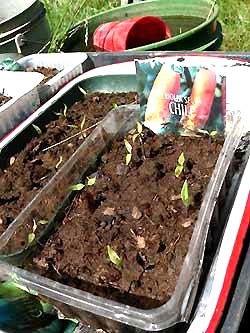
The main reason to sow seeds in trays and pots is to start your plants early, when it's still too cold to plant a garden outside. Start them indoors -- maybe beneath artificial light, next to a bright window, or else outside in a greenhouse or a cold frame. Then when it's warm enough you can transplant the seedlings into the garden.

Seedlings started indoors may get sunburned or shocked by the cold when taken outside. They may need to be "hardened off" -- subjected to outdoor sunlight and temperatures a little more each day until they're toughened. Once you move your plants outside, especially during the first two or three days, watch them closely to see if they're suffering.
An advantage to planting seeds in store-bought potting soil is that such soil should be free of disease organisms, weed seeds and insect eggs that may hatch into plant-eating bugs.
If you use good potting soil, then you just need to make sure your growing seedlings get the following:
- enough light
- the right amount of water
- enough warmth (house temperature usually OK)
- nutrients
- protection from physical damage( nosy cats)
Most seed packets tell you how deeply to plant the seeds, and how far apart to space the resulting seedlings when you transplant them. Most seed packages also tell how many days it takes for the seeds to germinate.
If you fertilize them, be sure to follow directions on the fertilize bottle or bag, for it's easy to kill plants with too much fertilizer!

It's nice to have pots and trays designed specifically for growing seedlings, but really you can use many kinds of containers. Be sure that each container has holes in its bottom to keep water from pooling in it. Sometimes it's a good idea to place trays and pots inside shallow trays. Then you can pour water into the larger trays and the water will seep up to the seedlings or germinating seeds from below. This manner of watering disturbs fragile seedlings less than if you sprinkle water from above.
Very small or older seeds may have reduced germination rate, so it may be a good idea to transplant your seedlings twice. First sow them thickly in a large, flat tray. Once the seedlings are up, separate them and plant them in individual pots or in trays farther apart, so each plant will have plenty of growing room.
During the first transplanting, first loosen the soil so when the seedling is removed its roots don't break. Don't grasp the seedlings by their stems, but rather take hold of a tip of one of the leaves. A good time to do it is when the seedling bears just its first two leaves (the cotyledons).
Label trays because it's easy to forget which seedlings are which, and often seedlings of different kinds of plants look very much alike, but need different care.